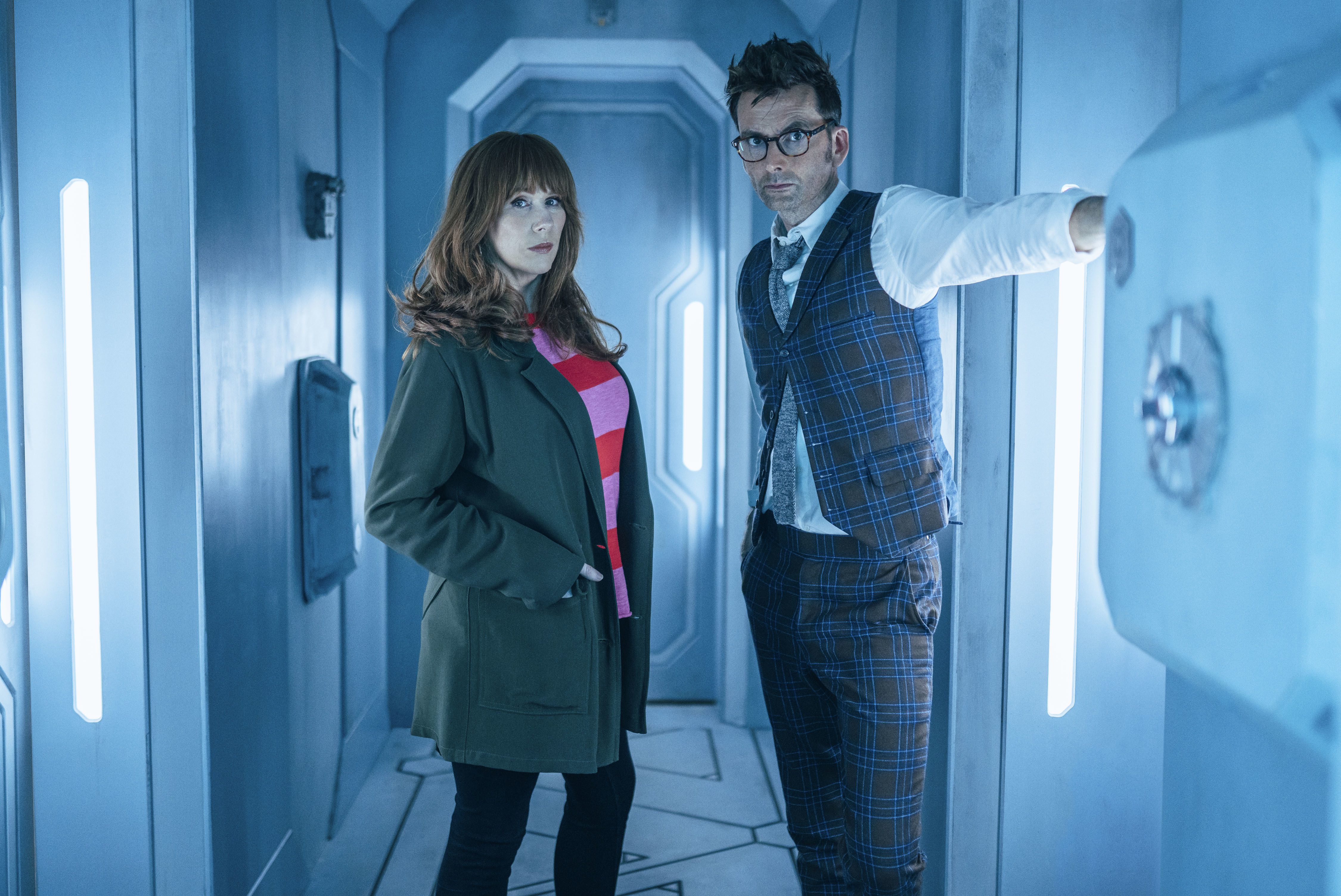Spoilers from the outset for this review of the Doctor Who 60th-Anniversary Special, “Wild Blue Yonder.”
As a recap, Donna (Catherine Tate) spilled coffee onto the TARDIS console, sending the temp from Chiswick (born in Southampton, as we learn in this episode) and the Fourteenth Doctor (David Tennant) out of control across time and space. The episode swiftly catches up with the TARDIS as it materialises (more appropriately, collides) with an apple tree in England. The year is 1666.
Moments before, an apple falls from the tree, landing on the head of Isaac Newton. With inspiration building, and a gravity joke from Donna, Newton mishears the word, sparking the concept of mavity – not gravity, mavity. Subsequently, every mention of the word is referred to this way. Sadly, this is the last we see of Newton, as the episode rejects the period setting for a much more sinister place. Newton was installed into the story for a recurring punchline, and little more.
The TARDIS abruptly appears inside a grungy antechamber aboard an abandoned alien spacecraft. The time machine begins the task of reparation since Donna’s coffee-related catastrophe. The Doctor and Donna discuss why, quite eerily, the TARDIS played Wild Blue Yonder (mispronounced as Wide Blue Yonder), a song made famous by the United States Air Force upon arrival, as the Doctor surveys the damage inside the time machine.
The sonic screwdriver is left in the keyhole for the repairs before the TARDIS swiftly vanishes under the threat of danger, courtesy of an onboard security failsafe known as the Hostile Action Displacement System – or HADS. So, where is the hostile action, and why is the ship devoid of life forms, save for one rickety, rusting robot nicknamed Jimbo, who, once in a blue moon, takes an ominous step forward?

The mystery deepens as a series of words, spaced apart, seemingly unrelated, and indecipherable, boom across the achingly long miles of corridor and antechambers of the craft while the walls of the ship shift. The Doctor and Donna, unknown to them, are spied through the gaps in the walls as they venture deeper into the ship. They further debate the Wild Blue Yonder song and Mrs Bean, the head of Choir at Donna’s school, who praised the track for being “jolly” despite its darker musical undertones.
Soon enough, the Doctor and Donna locate a cockpit (courtesy of a small anti-gravity, or mavity kart) to transport them down the lengthiest corridor in the universe. Zero life signs aboard the ship are coupled with an airlock door opening and closing, inexplicably, three years earlier, adding to the puzzle. A drone projected from the ship leads the Doctor and Donna to discover the craft idling at the edge of the known universe – beyond which lies absolute, eternal blackness, despite a hypothesis from the Doctor suggesting the ship became stuck in a mavity well.
As the walls move and the words resonate across the ship, the Doctor uncovers a room with baseplate repetition filaments, a series of compartmentalised metal plates used to power the spacecraft. With Donna left to switch the plates about, the Doctor manipulates water pipes in another antechamber. Donna contemplates how long her family would wait for her to return since vanishing in the TARDIS as the Doctor – returning to the chamber – kindly listens. In what feels like a sharp, unexpected jump cut, we return to the Doctor in the adjoining room – as Donna walks in.

As the Doctor reflects on Gallifrey and considers what happens to his time machine in the event it flees from danger – the penny drops with a resounding clang. Duplicated versions of the Doctor and Donna now occupy each room, listening to their real-life counterparts. As the duplicates share a complaint about the lengths of their arms, all becomes clear. An alien entity has copied the Doctor and Donna, feeding off their thought processes and adrenaline to manifest themselves into existence.
With freakishly elongated arms, elastic jaws and extra knees, the copies (deemed as No-Things by the Doctor) struggle with their shape and size, using heat and cold to create mass – while retaining the memories of those they impersonate. Originating from beyond the known universe, the No-Things infiltrated the ship. Their arrival led the Captain of the ship to commit suicide, walking out of the airlock three years earlier – and preventing the No-Things from fully assuming her form. The Captain is suspended inside a gravity (sorry, mavity) well circling the ship, causing the clanging noises outside the hull.
The No-Things, gradually acclimatising to their environment, require the Doctor to piece together the mystery aboard the ship – since the Captain died before they could discover what she had done before abandoning the craft – using his ability to think and act fast to evolve. The No-Things use the Doctor’s greatest weapon, his intellect, to best him and intend to incite war and destruction across the cosmos. So what did the Captain do?

The Captain installed a delayed self-destruct failsafe to destroy the ship. The words translate as numbers, and the walls reconfigure to prepare for the eventual detonation – while the robot, a mechanical being with unreadable thoughts, is tasked with walking the corridor across three years to trigger the failsafe and destroy the No-Things. It makes for a neat conclusion with a spectacular climax, underscored by a scintillating score from Murray Gold.
The eventual payoff after months of speculation, hype and mystery surrounding “Wild Blue Yonder” may leave some audiences displeased with the final product – yet based on its own merits, the episode is a sinister, ship-under-siege two-hander executed with style – and the closest to cosmic horror Russell T Davies has penned since the timeless classic “Midnight” in 2008.
That story featured an evolving entity who could mirror the actions of passengers aboard a sieged space cruise marooned on a diamond planet. Back to the special, the production values, performances and music are worthy of praise, coupled with a post-Flux conversation between the Doctor and Donna, an event which left half the universe devastated and the Doctor running from his past.

The scene further fixes the Flux series as canon in the larger Doctor Who timeline. Lastly, we have the surprise scene with the late and great Bernard Cribbins – who filmed a single, beautiful scene in the specials prior to his death in July 2022. Goodnight, old soldier.
Now, we await the arrival of The Toymaker, abruptly foreshadowed as everyone in London begins to brawl in the streets, and a plane crashes onto the city. As endings go, no one could have foreseen that. On an unrelated note – the Doctor agreed with Donna that Isaac Newton was hot.
You can read FlickLuster’s review for “The Star Beast” here.

